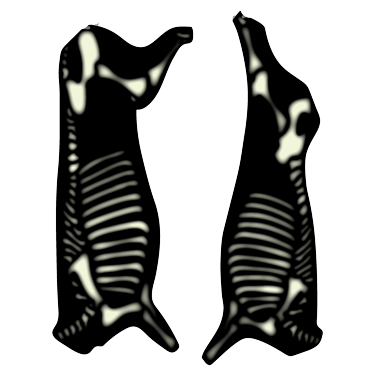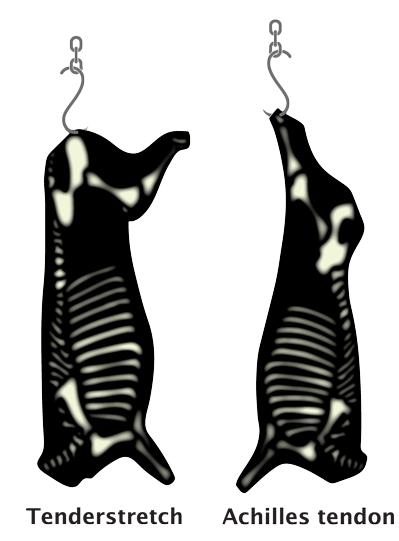Tenderstretch vs. Achilles Tendon: Which One Scores Higher?

Who in their right mind would say no to a tender cut of meat? The mere thought of a juicy, succulent steak is enough to make anyone develop a craving for it. Are you aware, however, that the tenderness of meat goes much further than the cut of meat alone? While natural factors like the age and breed of a particular animal are beyond human control, the meat industry does utilise the hanging process to reduce toughness in the meat. Following the initial steps of slaughtering and dressing the animal, its carcase can be hung using two techniques in order to improve the tenderness quotient of its meat cuts.
The need for hanging carcases
The process of meat stretching or hanging takes place after the animal is harvested and skinned, followed by the removal of its internal organs, head and feet.
Right after being slaughtered, the carcases are put in cold storage. While the lower temperature helps preserve muscle mass and prevent bacterial growth, it also has a disadvantage. As soon as the temperature goes below 12⁰C, the meat fibres contract as they reach a stage called “cold shortening”. If the cold shortening occurs before the carcase approaches the point of rigor mortis – or the stiffening of the body – it can turn the meat significantly tougher.
This is where the role of hanging the carcase comes into play. As can be guessed, this method of preventing meat contraction entails hinging the animal’s body through a part of its body and suspending it. Hanging allows the muscles to stretch and puts a curb on cold shortening.
How the Meat is Hung
Industrially speaking, there are two methods of meat hanging used, which are:
- Hanging through the Achilles tendon – As part of the more conventional Achilles method, the gambrels are placed inside the rear heels of the animal. With gravitational pull already acting on the carcase, there is greater tension in the muscle, producing relatively less tender meat than the tenderstretch method.
- Tenderstretch method – The tenderstretch technique usually involves positioning the gambrel beneath the pelvic hip bone, or below the ligament passing along the carcase’s backside. In this way, the legs hang perpendicular to the body, minimising muscle stiffness at the onset of rigor mortis. This technique has been found particularly beneficial for hindquarter portions.

Tenderstretch vs. Achilles Tendon Method
The two methods can be compared by taking the following factors under consideration:
- Ageing – Tenderstretched carcases age at a much faster rate, producing a commercially approved level of tenderness much quicker than Achilles-suspended animal bodies. Meat yielded from the Achilles tendon method, however, does become equally tender when given the time to age sufficiently.
- Electrical stimulation – When being readied for commercial consumption, Achilles-suspended carcases typically need to be electrically stimulated in order to achieve the ideal pH levels and temperature. Tenderstretching, on the other hand, helps avoid the use of electrical simulation altogether as it attains tenderisation solely on the basis of how the carcase is positioned.
- Uniformity in cuts – When it comes to yielding consumption quality meat, tenderstretching shows better results as it pretty much standardises the quality of each portion. Achilles tendon method, in comparison, produces meat cuts with noticeable different quality, particularly when the carcase belongs to an older animal.
- Economics – From an economic point of view, the Achilles-hanging method usually scores higher than tenderstretching. This is because many commercial chillers accommodate a higher number of Achilles-hung carcases than tender-stretched ones.
Which Method is Better and Why?
Although commercially, both methods are employed, consumer test results have shown that tenderstretching yields better results than the Achilles tendon method. Here are some reasons why:
- Prevents contraction during rigor mortis – In tenderstretching, the legs form a 90⁰ angle from the rest of the animal carcase, the muscles are in a constant stretched position. This prevents any resultant contraction due to rigor mortis, especially in the hindquarters.
- Yields faster results – From a commercial standpoint, tenderstretching can be advantageous because it encourages ageing to occur at a faster rate. As a result, it displays a faster turnaround for the production of tender meat. There are certain cuts, in fact, which show the same commercial quality when tender-stretched for two days as when they are Achilles-hung for two weeks.
- Spreads meat out evenly – Due to its right-angled posture, tenderstretched leg portions can experience significant changes from their natural form. This results in the meat surrounding the bone in equal proportions. The equal spreading out of meat is particularly appreciated by professional chefs and food connoisseurs.
- No electrical stimulation required – While it does produce immediate results, electrical stimulation needs to be regulated with precision, because a rapid decline in pH can lead to muscle shortening due to heat. Tenderstretching does not require any electrical stimulation and is attained completely naturally.
- Overall improved tenderness – A study by the Commonwealth Scientific and Industrial Research Organisation (CSIRO) in Australia studied the difference between the two hanging methods on cooked meat:
Effect on meat quality scores of suspending beef cuts.
Assessment by panel after grill cooking.
| Achilles Tendon | Tenderstretch | Change in Meat Quality | |
|---|---|---|---|
| Hindquarter | |||
| Tenderloin | 73.5 | 70.9 | Decreased |
| Rump | 56.9 | 63.9 | Improved |
| Striploin | 55.3 | 61.2 | Improved |
| Eye Round | 47.3 | 48.3 | No difference |
| Outside Flat | 46.7 | 50.4 | Improved |
| Topside | 37.8 | 44.9 | Improved |
| Forequarter | |||
| Cube Roll | 62.9 | 65.9 | Improved |
| Blade | 55.8 | 55.3 | No difference |
| Brisket | 34.7 | 31.9 | No difference |
Table data sourced from CSIRO Meat Technology Update, Feburary 2004
As more abattoirs and butchers opt for the Tenderstretch hanging method our dinner table steaks should get even better. Next time you're at your local butcher ask them what hanging method they use.

